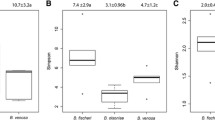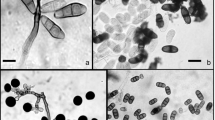Abstract
Endophytic fungal flora of the symptomless lamina and petiole of Acer saccharum have been compared to detect inter-sites and tissue-specific differences in the communities from two native and one urban stands. Twenty seven different fungal taxa were isolated, but only 19 endophytes were present in frequencies of colonization higher than 1 %. Although the species composition overlaps within sites, all of these species were found in an old-growth forest (300 years old), but only 18 (67 %) in a regenerated (managed) forest (80 year old) and 8 (30 %) in an urban plantation. Both, the numbers of species and fungal isolation frequency, were significantly higher for leaves than for petioles, showing an organ and segment-specific distribution. The gradually increasing of the presence of dark mycelia from native forests to urban plantation was discussed on the basis of the presumably impacts of the temperature and light following the 1998 ice-storm in Quebec, Canada.
Similar content being viewed by others
References
Bills GF, Polishook, JD (1991) Microfungi from Carpinus caroliniana. — Canadian Journal of Botany 69: 1477–1482.
Brisson J, Bergeron Y, Bouchard A (1988) Les successions secondaires sur sites mésiques dans le Haut-Saint-Laurent. — Canadian Journal of Botany 66: 1192–1203.
Brisson J, Bergeron Y, Bouchard A (1994) Beech-maple dynamics in an old-growth forest of southern Quebec, Canada. — Ecoscience 1: 40–46.
Brisson J, Millet J, Véroneau H, Beaudet M, Messier C, Bouchard A (1999) Effet du verglas de janvier 1998 sur la dynamique forèstiere à la réserve écologique du Boisé-des-Muir. Rapport présenté à la Direction de la conservation et du patrimoine écologique, Ministère de l’Environnement, Québec. Institut de recherche en biologie végétale, Montréal. 36 p.
Brisson J, Lareau C, Millet J, Bouchard A (2001) Tree damage and recovery after the 1998 ice storm in an old-growth forest of eastern North America. In L’arbre 2000: 200 The tree (ed. M. Labrecque), Institute de recherche en biologie végétale et Isabelle Quintin: Montréal, Qc., Canada, pp. 307–313.
Beaudet M, Messier C, Paré D, Brisson J, Bergeron Y (1999) Possible mecanisms of sugar maple regeneration failure and replacement by beech in Boisé des-Muir old-growth forest, Quebec. — Ecoscience 6: 264–271.
Buck JW, Lachance M-A, Traquir JA (1997) Mycoflora of peachbark: population dynamics and composition. — Canadian Journal of Botany 76: 345–354.
Carroll GC (1988) Fungal endophytes in stems and leaves: from latent pathogen to mutualistic symbiont. — Ecology 69: 2–9.
Carroll GC 1995. Forest endophytes: pattern and process. — Canadian Journal of Botany 73(Suppl. 1): S1316–S1324.
Chapela IH (1989) Fungi in healthy stems and branches of American beech and aspen: a comparative study. — New Phytologist 113: 65–75.
Clay K (1996) Interactions among fungal endophytes, grasses and herbivores. — Researches on Population Ecology. 38: 191–201
Colladp J, Platas G, Gonzales I, Pelaéz F (1999) Geographical and seasonal influence on the distribution of fungal endophytes in Quercus ilex. — New Phytologist 143: 525–532.
Connell JH (1978) Diversity in tropical rain forests and coral reefs. — Science 199: 1302–1310.
Cotter H, Van T, Blanchard R (1982) The fungal flora of bark of Fagus grandifolia. — Mycologia 74: 836–843.
Crow T (1990) Biological diversity and forest planning. Building a forest resource constituency (D.G. Brockway, editor). Proceedings of the North-eastern Forest Resource Planners Association 1989 Annual Conference. USDA Forest Service and Michigan Department of Natural Resources. pp. 78–81
Dehayes DH, Schaberg PG, Hawley GJ, Strimbeck GR (1999) Acid rain impacts on calcium nutrition and forest health. — BioScience 49: 789–800.
Dickinson CH (1986) Adaptations of micro-organisms to climatic conditions affecting aerial plant surfaces. In Microbiology of the Phyllospere. (ed. N.J. Fokkema & J. van den Heuvel), Cambridge University Press, Cambridge, U.K., pp. 77–100.
Espinosa-Garcia FJ, Langenheim JH (1990) The endophytic fungal community in leaves of coastal redwood population-diversity and spatial patterns. — New Phytologist 116: 89–97.
Fiscer PJ, Petrini O, Petrini LE, Sutton BC (1994) Fungal endophytes from the leaves and twigs of Quercus ilex L. from England, Majorca and Switzerland. — New Phytologist 127: 133–137
Huston M (1979) A general hypothesis of species diversity. — American Naturalist 113: 81–101.
Johnson JA, Whitney NJ (1989) A study of fungal endophytes of needles of balsam fir (Abies balsamea) and red spruce (Picea rubens) in New Brunswick, Canada, using culture and electron microscope techniques. — Canadian Journal of Botany 67: 3513–3516.
Kliejunas JT, Kunz JE (1974) Microorganisms associated with Eutypella parasitica in Acer saccharum and A. rubrum. — Canadian Journal of Forest Research 4: 207–212.
Kuter GA (1986) Microfungal populations associated with the decomposition of sugar maple leaf litter. — Mycologia 78: 114–126.
Lachance D, Hopkin A, Pendrel B, Hall JP (1995). Health ofsugar maple in Canada. Canadian Forest Service, Natural Resources Canada, Inf. Rep. ST-X-10. Ottawa. p. 26.
Melancon S, Lechowicz MJ (1987) Differences in the damage caused by glaze ice on codominant Acer saccharum and Fagus grandifolia. — Canadian Journal of Botany. 65:1157–1159.
Millers I, Shriner PR, Rizzo S (1989) History of hardwood decline in eastern United States. USDA Forest Service Gen. Tech. Rep. NE-126.
Okane I, Nakagiri A, Ito T (1997) Endophytic fungi in leaves of ericaceous plants. — Canadian Journal of Botany 76: 657–663.
Petrini O, Carroll GC (1981) Endophytic fungi in foliage of some Cupressaceae in Oregon. — Canadian Journal of Botany 59: 629–636.
Petrini O (1986) Taxonomy of endophytic fungi of aerial plant tissues. In Microbiology of the Phyllospere. (ed. N.J. Fokkema & J. van den Heuvel). Cambridge University Press, Cambridge, U.K., pp. 175–187.
Petrini O (1991). Fungal endophytes of tree leaves. In Microbial Ecology of Leaves (ed. J.H. Andrews & S.S. Hirano), Springer Verlag: New York, Berlin, Heidelberg, London, Paris, Tokyo, Hong Kong, Barcelona, Budapest, pp. 179–197.
Petrini O, Sieber TN, Toti L, Viret O (1992) Ecology, metabolite production, and substrate utilisation in endophytic fungi. — Natural Toxins 1: 185–196.
Roberts MR, Gilliam FS (1995) Patterns and mechanisms of plant diversity in forested ecosystems: implications for forest management. — Ecological Applications 5: 969–977.
Robitaille G, Boutin R., Lachance R (1994) Effect of soil freezing stress on sap flow and sugar content of mature sugar maples (Acer saccharum). — Canadian Journal of Forest Research 25: 577–587
Sahashi N, Kubano T, Miyasawa Y, Ito S (1999) Temporal variation in isolation frequency of endophytic fungi in Japanese beech. — Canadian Journal of Botany 77: 197–202.
Sahashi N, Miyasawa Y, Kubano T, Ito S (2000) Colonization of beech leaves by two endophytic fungi in northern Japan. — Forest Pathology 30: 77–86.
Saikkonen K, Faeth SH, Helander M, Sullivan TJ (1998) Fungal endophytes: a continuum of interactions with host plant. — Annual Reviews of Ecological Systems 29: 319–343.
Sas Institute (1997) The SAS system for Windows 95. Cary, NC: SAS Institute Inc.
Schultz B, Guske S, Dammann U, Boyle C (1998) Endophytehost interaction. II. Defining symbiosis of the endophyte-host interaction. — Symbiosis 25: 213–227.
Schultz B, Römmert A-K, Dammann U, Aust H-J, Strack D (1999) The endophyte-host interaction: a balanced antagonism? — Mycological Research 103: 1275–1283.
Sieber TN (1989) Endophytic fungi in twigs of healthy and diseased Norway spruce and white fir. — Mycological Research 92: 322–326.
Sieber TN, Dorworth CE (1994) An ecological study about assemblage of endophytic fungi in Acer macrophyllum in British Columbia: in search of candidate mycoherbicides. — Canadian Journal of Botany 72: 1397–1402.
Sieber TN, Hugentobler C (1987) Endophytische Pilze in Blättern and Ästen gesunder and geschädigter Buchen (Fagus sylvatica L). — European Journal of Forest Pathology 17: 411–425.
Sieber TN, Sieber-Canavesi F, Dorworth CE (1991) Endophytic fungi of red alder (Alnus rubra) leaves and twigs in British Columbia. — Canadian Journal of Botany. 69: 407–411.
Sieber TN, Rys J, Holdenrieder O (1999) Mycobiota in symtomless needles of Pinus mugo ssp. uncinata. — Mycological Research 103: 306–310.
Stone JK, Sherwood MA, Carroll GC (1996) Canopy Microfungi: Function and Diversity. — Northwest Science 70: 37–45.
Van Den Berg A, Donelly J, Shaberg P, Murakami P (2000) Development of fall foliage color in sugar maple. 4th International Symposium-THE TREE, Institute de recherche en biologie végétale/Montreal Botanical Garden. August 20–26, Montreal, Quebec, Canada. Abstracts, pp. 39–40.
Vujanovic V, Brisson J (2001) Biodiversité microfongique du Fagus grandifolia dans une forêt ancienne: bioindicateurs et structure mycosociologique. — Canadian Field-Naturalist 115: 34–42.
Xin Z, Browse J (2000) Cold comfort farm: the acclimatation of plants to freezing temperature. — Plant, Cell and Environment 23: 893–902.
Wilson D (2000) Ecology of woody plant endophytes. In Microbial endophytes (ed. by CW Bacon and JF White, JR.) Marcel Dekker Inc, New York, Basel, pp. 389–419.
Author information
Authors and Affiliations
Rights and permissions
About this article
Cite this article
Vujanovic, V., Brisson, J. A comparative study of endophytic mycobiota in leaves of Acer saccharum in eastern North America. Mycol Progress 1, 147–154 (2002). https://doi.org/10.1007/s11557-006-0014-y
Accepted:
Issue Date:
DOI: https://doi.org/10.1007/s11557-006-0014-y




